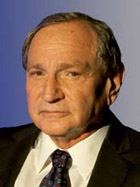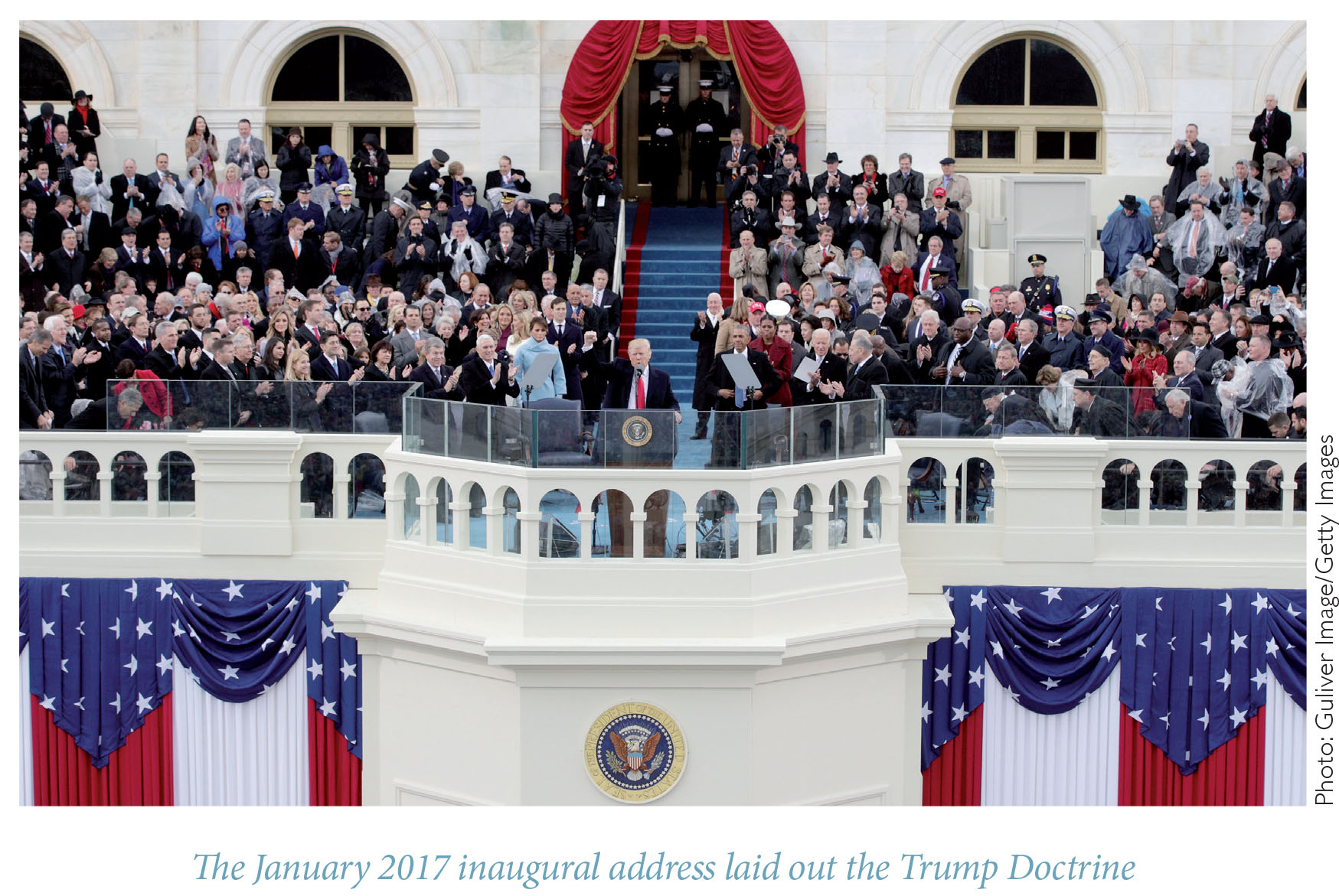
 George Friedman is Chairman of Geopolitical Futures and a best-selling author of books on geopolitics and the future of the international system, such as The Next 100 Years (2009), The Next Decade (2010), and Flashpoints: The Emerging Crisis of Europe (2016). Jacob L. Shapiro is Director of Analysis at Geopolitical Futures and guides the analysis and forecasting process. You may follow them on Twitter @GPFutures.
George Friedman is Chairman of Geopolitical Futures and a best-selling author of books on geopolitics and the future of the international system, such as The Next 100 Years (2009), The Next Decade (2010), and Flashpoints: The Emerging Crisis of Europe (2016). Jacob L. Shapiro is Director of Analysis at Geopolitical Futures and guides the analysis and forecasting process. You may follow them on Twitter @GPFutures.
During the campaign for the American presidency, Donald Trump expressed a clear set of foreign policy goals. This was often missed, because it was embedded in his unique rhetoric. Trump’s rhetoric is a problem, but so is conventionally clear political rhetoric that says nothing. Observers too readily dismiss what Trump says as naiveté at best, and the ravings of a madman at worst. Too often such characterizations obscure the fact that he has a real and coherent strategic vision.
Trump’s core strategic argument is that the United States is overextended. In Trump’s view, the United States should spend less time and expend fewer resources on a system of multilateral relationships, and more on the national interests of the United States. Washington is entangled in complex relationships that place risks and burdens on the United States to come to the aid of some countries. However, those countries do not match American commitments in capability or intent.
This essay has two objectives: first, to give an unbiased and objective description of Trump’s foreign policy doctrine; and second, to examine how Trump has already had to modify some of his plans since assuming the office of the president. Policy is what one wants to happen; geopolitics is what does happen. Trump is in many ways an unprecedented American president. Like all U.S. presidents, though, the gulf between what he wants and what is possible is wide.
Trump’s foreign policy doctrine consists of three key ideas. The first is that the United States has allowed itself to become overextended in honoring its alliances. The second is that America should think about trade in terms of what is best for the United States and not what is best for the global economic system. The third is that rigid multilateralism is a relic of the Cold War world. In the age of American hegemony, the United States should work with whoever shares its interests, rather than clinging to a structure that has outlived its utility.

Overextension by Alliance
There are many examples of the United States overextending itself for the sake of alliance, but NATO is the most obvious and important. NATO was created as a bulwark against the Soviet Union. It worked well as a collective security organization, with this specific security goal as its raison d’être. NATO was the West’s brick wall to the USSR’s Iron Curtain.
NATO has lost the enemy that gave it purpose. Furthermore, so many countries have joined NATO in the last 20 years—a total of 12—that establishing common purpose or priorities is difficult, if not impossible. Montenegro has now become NATO’s 29th member. NATO officials speak about Montenegro as if adding a country with less than a million people will stabilize the situation in Southeast Europe. This is absurd when any real thought is given to it. It is also indicative of why Trump has insisted that the relationship with NATO should be re-evaluated.
The result of all this is that NATO has become a collective security organization with no uniform sense of what it is protecting securing against. In the meantime, the United States has been involved in wars in Afghanistan, Iraq, and elsewhere in the Islamic world. Many NATO countries either provided the support they could or the support they wanted to provide during these wars. But that level of support was not decisive and was far below the full capabilities of NATO members. NATO guidelines stipulate that all countries should spend 2 percent of their GDP on defense. Besides the United States, only four of the other 28 members spend the requisite amount. America foots the bill for over 70 percent of NATO spending.
Twenty-one NATO members are also EU members. Together, these EU members have roughly the same collective gross domestic product as the United States, and a larger population. They also have a substantial industrial base. Europe has come well beyond where it was at the time of NATO’s founding, when it was incapable of collective defense without the United States. NATO members have taken for granted that Washington will bear the primary burden for defense, measured not only in terms of dollars spent, but also in the development of military capabilities.
Equally important, the primary strategic activity of the United States for the past 15 years has been in the Islamic world. Many in NATO objected to the American operation in Iraq and, with the exception of the United Kingdom, provided little or no significant support. Alliance members have no obligation to join in conflicts initiated by the United States outside the area of NATO’s focus. Trump accepts that principle, but points out that the organization has been irrelevant to American strategic needs. Where the alliance engaged, it did so with far too little might to constitute a strategic force. The reasonable argument that the Atlantic Alliance makes no commitment to out-of-area engagements not undertaken under Article 5 raises the question of what, then, is NATO’s value to the United States?
It is therefore unclear whether NATO, as currently constituted, is of value to the United States. America is liable for the defense of Europe; Europe is not liable for defending American interests, which today lie outside Europe. Trump believes this relationship must be mutually renegotiated. If the Europeans are unwilling to renegotiate, the United States should exit NATO and develop bilateral relations with countries that are capable and prepared to work with America in areas of its national interest, in return for guarantees from Washington.
This principle applies to all U.S. relationships—not just NATO, and not just Washington’s bilateral relationships with European capitals. Trump wants to re-examine all of America’s relations with other nations, including allies such as Japan and South Korea, in order to ensure that the relationships remain valuable to all parties, and the level of effort and risk reflects such a value.
Trading Benefits
The same view holds true for Trump’s policy on foreign trade. It is not clear that the United States has benefited from the current international trade regime. International trade is not an end in itself; it must serve each party’s interests. At this point in history, the primary economic need in the United States is to create trade relations that build American jobs. The previous goal of aggregate economic growth without regard to societal consequences is no longer acceptable. The terms under which most international trade agreements have been structured are now unacceptable. Free trade may well increase GDP, but it does not deal with critical societal issues.
Large, multilateral free trade agreements are far too complex to fine-tune to American interests. They need to be avoided in favor of bilateral treaties or smaller ones, such as NAFTA, which can be reshaped to serve the current American interest. In these negotiations, the United States—producing about 25 percent of the world’s GDP—holds the stronger hand. America’s primary concern must be the same as that of other countries: trade relations that are beneficial to the United States, and not an abstract commitment to free trade.
Much ink has been spilled over NAFTA, and Trump has made a special point of singling it out as one of his signature issues. But the real elephant in the room when it comes to trade for Trump is China. China has a massive economy that is highly dependent on exports to America. It has offered an environment where American companies can transfer production and increase their revenue and profits while hollowing out the industrial base of the United States. It has also gained a significant market share in American imports. China’s share of such imports has risen from 9.3 percent in 2001 to 21.4 percent in 2016. Meanwhile, Mexico’s share of such imports has remained relatively consistent, while Canada’s has dropped over the same period.
Trump does not want this situation to continue. At this point, Chinese trade dependence on the United States is substantially greater than American trade dependence on China. In addition, the United States has a strategic advantage over China, demonstrated by Trump’s willingness to consider disregarding the “one China” concept. America currently has the economic and strategic advantage to compel China to negotiate the trade relationship.
The End of Multilateralism
A merica’s central foreign policy preoccupation—and one shared by other countries—is Islamic radicalism, especially in its latest manifestation, the Islamic State. IS poses a terrorist threat that some have minimized, but which Trump regards as an intolerable menace for two reasons. First, as 9/11 demonstrated, attacks can be escalated. Second, the psychological burden of terrorism is enormous. The terrorist threat cannot be defeated without overwhelming power being brought to bear on the Middle East. Living with terrorism indefinitely is not an option. Therefore, the United States and its allies must bring overwhelming force to bear.
The United States is ready to work with any ally prepared to dedicate resources to this goal and to share risks. This includes Russia, which has an internal problem with Islamic terrorists and has significant capabilities it could deploy. Trump sees American and Russian interests as coinciding. For instance, Washington and Moscow could agree on the neutralization of Ukraine: Kiev would have economic and political ties with the West, but Ukraine would neither be part of any alliance system, nor would it be a base for Western forces. The United States wants a buffer to protect allies in Eastern Europe, but beyond that it has no overriding interest in Ukraine. Russia wants a degree of autonomy in eastern Ukraine and to retain its interests in Crimea, where it has treaty rights in Sevastopol anyway. The Ukrainian issue can be managed in the context of joint anti-Islamist operations. Trump is, of course, aware of Russia’s economic problems and sees therein a lever to achieve his goal.
For Trump, the key is to recognize that the post-World War II period of multilateralism is over, and that continuing to act otherwise is harming American interests in multiple ways. For the United States, 9/11 remains a defining moment, and 15 years of unsatisfactory operations in the Middle East do not mean that a solution is unattainable.
Since NATO members are either unwilling to commit to this effort or have very little to commit, the United States is seeking other nations with a common interest. One potential partner, in a limited sense, is Russia. Trump is more interested in a strong America partnering other strong countries to achieve mutual interests. He prefers this to a façade of universal ideals supported by all, but where nothing actually gets done.
Enter Geopolitics
Trump, then, has a coherent foreign policy doctrine. Many presidents have ambitious and coherent plans for remaking the world once they come to power. These ambitions are usually thwarted by reality. Consider the pledges Trump made on the campaign trail. He said that upon entering office he would direct his Treasury Secretary to label China as a currency manipulator. He said that the United States would not tolerate Chinese military provocations in the South China Sea, and he said that accepting the “one China” policy was not a foregone conclusion. He also said that he would rip up the Iran deal and inform Mexico and Canada that the United States would leave NAFTA in six months. He went on to say that he would move the U.S. Embassy in Israel to Jerusalem, that he would crush the Islamic State with an ingenious secret plan, and that NATO, Japan, South Korea, and all American allies should be on notice. In short, he said that things would not be done the way they were before, and everyone would have to pull their own weight—or even acquire their own nuclear weapons.
If the rhetoric is ignored and what Trump has done is analyzed, a much different picture materializes. The United States has not labeled China a currency manipulator. Trump has personally told Chinese President Xi Jinping that he will accept the “one China” policy. The first visit of Trump’s Defense Secretary was to Japan and South Korea—to reassure them that American security guarantees are ironclad. Crushing the Islamic State has become a request for a plan to better combat IS in Syria and Iraq. The Iran deal remains in place. NAFTA remains in place. Trump is reconsidering moving the U.S. Embassy in Israel to Jerusalem and has criticized the current Israeli government for building settlements. Most sanctions against Russia have remained in place and Trump has personally reassured Ukrainian leaders that the United States is not going to abandon Kiev to the Russians. The gulf between what Trump wants to do and what he can do is wide indeed.
W hen it comes to China, it must be understood that the trade relationship is a two-way street. The United States has significant leverage—but Trump campaigned on a populist message to improve the lives of the middle class. The United States is a major importer of cheap Chinese goods. If Trump is going to produce accomplishments that will satisfy his base, he needs a cooperative China, not a combative one. America must also work with China on North Korea and on resolving disagreements in the South China Sea. Grandstanding over “one China” has served its purpose; now Trump must produce results.
Trump may not like NAFTA, but here he is strained at the domestic level. The states that border Mexico—California, Arizona, New Mexico, and Texas—are all to varying degrees dependent on their economic relationship with Mexico. Congressmen and senators from these states cannot support the repeal of NAFTA without risking their own positions. Trump’s executive powers over NAFTA are unclear, but the domestic political backlash to withdrawing from NAFTA would be politically devastating—both for Trump and the Republican Party.
As for the Middle East, Trump is imprisoned by a lack of options on the table for an immediate turnaround. The U.S. military has been at war for almost 16 years and is depleted, and domestic political will for another large military campaign in the Middle East is dubious at best. Trump may initiate a military-rebuilding program, but in the meantime, the United States will require allies to continue pushing back IS. Iran is one such ally, and it has been effective in turning the tide against IS in Iraq. Support from Arab countries will be critical as well, and moving the embassy to Jerusalem and inviting Israel to annex the West Bank would undermine any American attempt to garner support for a regional coalition against IS. Whatever Trump’s desires or positions, his choices are far more limited.
Marx vs. Anti-Marx
Trump has his own way of saying things. His style often obscures his substance. A dispassionate analysis of what he says shows that he has a coherent and radical foreign policy doctrine. Trump is proposing a redefinition of American foreign policies based on current realities, not those of 40 years ago. It is a foreign policy in which American strength is maximized to achieve American ends.
Trump believes that U.S. policy has been reflexively committed to arrangements that are three-quarters of a century old, and that the time has come for a change. But the issue now is not what Trump’s vision was; the issue now is what his presidency will become. This will not be up to Trump. As Karl Marx said, “men make their own history, but they do not make it as they please.” All the more so for presidents.








